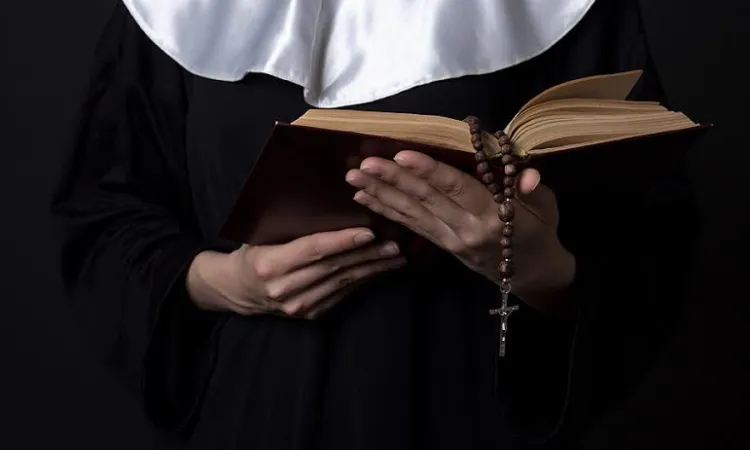Originally founded in 1625 in France, the foundress of Stanbrook Abbey in England was Dame Gertrude More, the great-great-granddaughter of St. Thomas More. Dame Laurentia McLachlan, O.S.B., was abbess of Stanbrook between 1931 and 1953. Through her rich but unassuming letters, this cultivated nun maintained remarkable friendships with men and women of every walk of life. The agnostic Sydney Cockerell and the playwright George Bernard Shaw corresponded with her for many years. The belles lettres of Lady Abbess elicited from Shaw this comment to her: "Though you are an enclosed nun, you do not have an enclosed mind."
Dame Laurentia McLachlan and her community pioneered the restoration of Gregorian chant in England, and she was a leading authority on music and medieval manuscripts. Her work was recognized by Pius XI who bestowed on her the Bene Merenti medal for her contribution to Church music.
Stanbrook Abbey served as the model for Rumer Godden's novel, In This House of Brede, a fictionalized account of Benedictine monastic life in the twentieth century.
Abbey of Regina Laudis
More in The Way of Beauty
The Benedictine nuns at the Abbey of Regina Laudis are perhaps the best-known monastic community of cloistered nuns in this country. Its foundress, Mother Benedict Duss, was a medical doctor in France before becoming a Benedictine nun at the Abbey of Notre Dame de Jouarre. The movie, "Come to the Stable," is based on the historical facts that led her to Bethlehem, CT after World War II. Later she discovered that General George S. Patton had liberated that Abbey from the Nazis.
Women who enter Regina Laudis Abbey are said to be accomplished in various disciplines which can support the monastic community from within the enclosure. Here only four nuns will be mentioned. The current Abbess, Dame Lucia Kuppens, holds a Ph.D. in English literature from Yale University. Under her visionary leadership, the monastery is engaged in the New Horizons Renovations project that will increase the number of its buildings and renovate the old ones. She oversees a vast land project and a burgeoning Monastic Intern program.
Mother Margaret Georgina Patton, O.S.B., a trained horticultural therapist, cares for the Abbey gardens. She is the granddaughter of General George S. Patton (mentioned above), best known for his leadership of the Third Army in France and Germany following the Allied invasion of Normandy in June 1944.
The former Hollywood actress Dolores Hart, now Mother Dolores Hart, maintains ties with Hollywood and is a voting member of the Oscar nominating committee. She directs the Abbey's open-air theater and arts program. When the actress Patricia Neal died in 2010 as a new convert to the Catholic faith, she was buried on the grounds of Regina Laudis. A lifelong friend of Mother Dolores Hart, she was an enthusiastic supporter of the Abbey's theater and arts program.
Mother Jerome Von Nagel Mussayassul, O.S.B. was known before her marriage as Baroness Melanie Von Nagel. She married a Muslim, Kahlil Mussayassul, and after his death, she became a convert to Catholicism and a cloistered but extern Benedictine nun. She devoted her life to scholarship, writing, and translating in the spirit of her namesake, Saint Jerome. She died in 2006 at ninety-eight.
At Regina Laudis, Gregorian chant is sung daily at the Divine Office. The nuns convey its power to communicate the presence of God as no other music does.
Consecrated Life: the Active Institutes
(Column continues below)
Subscribe to our daily newsletter
Consecrated women who conduct ministries in external social venues like schools, hospitals, foreign missions, retreat houses, and homes for unmarried and abused pregnant women are referred to as sisters. Daily prayer and other religious exercises are integrated with their ministry, and one is done for the sake of the other. Thousands of women religious are dedicated to others in ways known only to the beneficiaries of their love.
Often the foundational Rule of a religious institute specifies its mission as with the Sisters of Charity of Mother Teresa. No one who has read about them or worked for a time with them can fail to be moved by their remarkable dedication to the destitute poor. Human logic defies explaining how these women can take men, women, and children left to die in the gutter and with tender compassion, prepare them for a peaceful and dignified death. What is done for these least ones is done for and to Jesus Christ.
Women enter a monastery or convent with their own unique narratives and gifts. The journalist Kate O'Beirne, a graduate of Good Counsel College, notes that the early appearance of female leadership in this country was assumed by consecrated women who served as college presidents.
Sister Madeleva, C.S.C., internationally-known poet and educator, was president of St. Mary's College, Notre Dame, IN for twenty-seven years. Her circle of friends included Edith Wharton, C.S. Lewis, and Joyce Kilmer. As a college educator, Sister Madeleva deplored the piecemeal education of sisters and initiated efforts to establish higher degrees in theology at Catholic institutions across the nation. Sister Elizabeth A. Johnson, C.S.J. was the first female theologian to join the faculty of theology at The Catholic University of America.
Sister Luke Tobin, S.L., a leader among her own sisters, was one of a few women invited to the Second Vatican Council as an auditor and planner of the sessions.
Mother Georgia Stevens, R.S.C.J., a convert to the Catholic faith, erected the Pius X School of Liturgical Music at Manhattanville College of the Sacred Heart, Purchase, NY (renamed Manhattanville College). With the collaboration of Mrs. Justine B. Ward and others, she was dedicated to the refinement of the Church's liturgical music, especially Gregorian chant. Mother Josephine Morgan, R.S.C.J. taught music at Manhattanville and headed the committee that published the Pius X Hymnal.


